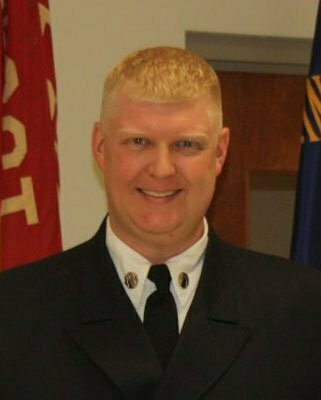Experiences Gained: Utilities Should Communicate with Local Governments Early and Often
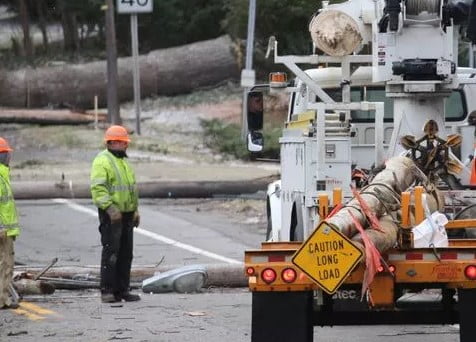
Utility workers clean up downed power lines and debris after wind gusts reaching 80 mph swept through Rochester, New York and surrounding areas in March 2017. Photo courtesy of Monroe County Office of Emergency Management.
During and after a natural disaster, utilities and local governments must work together to ensure the safety of citizens and navigate the restoration of infrastructure. Accordingly, it is critical they share an understanding about roles, responsibilities and processes during a disaster.
Even when utilities and local governments have a productive, well-established relationship with each other, miscommunications and problems can easily occur once a disaster hits.
“We have a close relationship with our utility,” explains Tim Kohlmeier, deputy safety director for Monroe County, New York. “They’re our partners. We share well-established critical infrastructure lists. And we have a great communications liaison,” he explained. And yet, the utility and county found themselves struggling to work together during a severe windstorm in March 2017. “Our utility responded very well to the situation, but their failure was in their inability to communicate; it all comes down to communications.” Following the disaster, the utility and county are implementing measures to improve communications on all fronts.
The severe windstorm caused multi-day power outages for more than 125,000 residents in the county. An identical forecast the previous week had caused only a few power outages; accordingly, most residents ignored severe wind warnings.
“No one’s going to listen the second time around if nothing happened the first time,” Kohlmeier says. This was the first of many communications barriers, that despite extensive and well-implemented planning, presented unexpected obstacles throughout the response and recovery process.
To make matters worse, sub-zero temperatures followed while most residents were still without power. No longer just an inconvenience, restoring power became a life-or-death situation. Frail, at-risk populations were even more at-risk; residents had to seek shelter or find a safe way to keep warm in their homes. “Zero degrees is zero degrees, regardless of age, health or income,” Kohlmeier says.
Lesson #1: Review emergency operations plans with emergency management on a regular basis. Establish and maintain relationships.
When the windstorm hit Monroe County, Kohlmeier didn’t have the utility’s emergency operations plan (EOP). Unbeknownst to Kohlmeier and his team, the utility’s communications liaison to emergency management was part of the utility’s emergency response team and was unavailable to field emergency management’s questions.
“During a small power outage, we’ll call our liaison and get answers,” Kohlmeier explains. “But during the emergency, she wasn’t in the information loop.”
To complicate the situation further, the utility had recently been bought out by an international company and few utility workers were familiar with the community or had experience dealing with such a large-scale event.
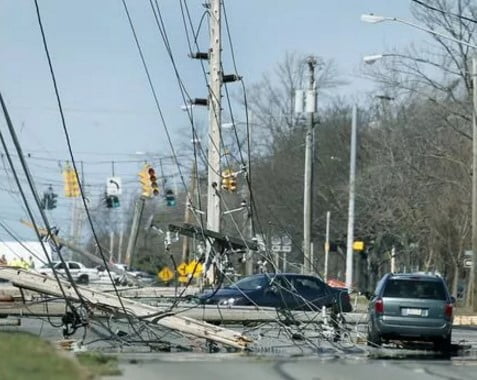
Abandoned cars on a main road in Monroe County after the wind storm swept through. Winds brought down 3,000 power lines and snapped more than 400 poles. Photo courtesy of Monroe County Office of Emergency Management.
Pre-incident, utilities should share and thoroughly review their EOP with the local government. Likewise, utilities should review emergency management’s plans and have a clear expectation of what their responsibilities will be during an emergency. It’s also important to reach out to emergency management and other municipal departments when leadership shifts in the utility or in the local government. New leaders on both sides should be briefed on how the utility and emergency management will work together to navigate disaster recovery. Knowing who to call to jump-start operations saves precious time and may save lives. “I had just come into my position and assumed this all had been done and relationships had been established, but it wasn’t that way,” Kohlmeier recalls.
Kohlmeier stresses the importance of knowing who your point of contact will be in an emergency and building a relationship with them ahead of time. “Have their contact information on-hand, invite them to participate in your training exercises,” he says. Most importantly, make sure to assign operational staff to assist with incident command.
“It took us until day three before we found out that the liaisons assigned to the emergency operations center (EOC) were from the utility’s consumer development division,” Kohlmeier says. “It’s not that they weren’t helpful, they were just the wrong people to be sitting at the desk.”
Likewise, make sure utility leaders and liaisons to the local government have a clear understanding of their responsibilities and roles in the incident command structure — utility leaders play a support function in emergency management’s operations, not a leadership role. “The utility treated the event as if it was their emergency, but we had to establish that they were a subset of our command structure,” says Kohlmeier. Have these discussions pre-incident to create a symbiotic relationship at the leadership level and down the chain of command for both the utility and emergency management.
Lesson #2: Have clear expectations on what information emergency management will need from the utility during a major power outage.
During the windstorm, Kohlmeier and his team struggled to get important and specific updates from the utility. “Without power restoration times, it puts a huge burden on emergency management to be able to deal with residents’ decision-making,” he explains.
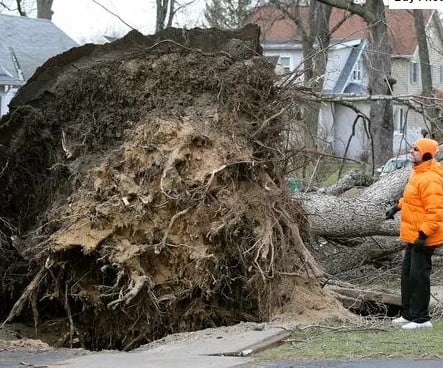
A Monroe County resident assesses the damage to his property. Severe winds knocked down trees across the county, causing damage to hundreds of homes and miles of sidewalk. Photo courtesy of Monroe County Office of Emergency Management.
Emergency management also struggled to make an informed decision about shelter operations. “Do we open one shelter or 10 shelters?” Kohlmeier adds. “It was a cascading affect because we didn’t have information.”
Lack of communication on critical updates during an event often results from lack of planning before the event. Utilities may be unaware of who to share information with and when. Before the event, make sure you understand emergency management’s expectations — how often they will need updates on power restoration times, the status of critical infrastructure and any other information that may be relevant to emergency management operations. Request or create your own checklist and timeline of information emergency management needs from you during an event. These can include items such as “After 24 hours, the utility has to provide a power restoration estimation,” or “Every 12 hours, the utility must provide a critical infrastructure status update.”
Kohlmeier recommends using your public utilities commissioner (or the regulatory agency that oversees utilities) as a mediator if communications barriers do arise between the local utility and emergency management during an event. Because the commission oversees utilities, they may be able to better manage requests for information, such as restoration estimates for power or critical infrastructure.
Lesson #3: Make sure you have a special needs population list that is prioritized and cross-checked regularly with the utility’s.
Utilities are required to have a special needs population registry to identify residents who need to be put on a priority power restoration list, and must do daily status check-ins on these residents.
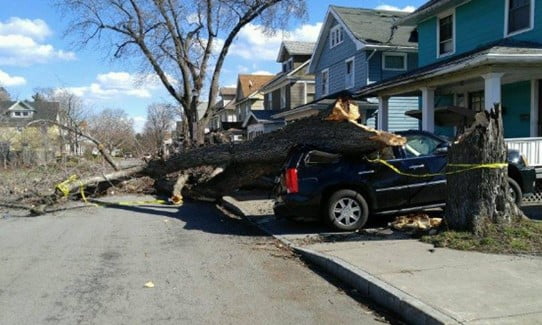
A car destroyed by a downed tree as a result of the March 2017 severe windstorm. The storm caused multi-day power outages for more than 100,000 residents in the county. Photo courtesy of Monroe County Office of Emergency Management.
It’s a good idea for utilities to share updates on special-needs and at-risk residents with your local emergency management agency during an event. Emergency management can assist utilities by sending patrol cars door-to-door if residents don’t pick up.
Kohlmeier was in the process of getting the utility’s registry to develop a special needs population list for emergency management when the windstorm hit. He suggests frequently cross-checking special needs lists between emergency management and utilities to ensure contact and medical information are up-to-date. He also recommends that the utility and emergency management work together to prioritize the list pre-incident, using a tiered system to categorize by medical condition and creating subdivisions within each that rank residents by level of risk.
Health Insurance Portability and Accountability Act (HIPPA) issues are a common area of concern for utility companies releasing the list to agencies. Once Kohlmeier and his team finally got the utility’s list, for example, it was stripped of medical and personal information due to the utility’s concern with violating HIPPA privacy restrictions. Have a system in place for sharing adequate information without violating privacy restrictions. Sharing this information pre-incident, when you’re not making decisions under duress, can ease many of these concerns.
“Once we got the list during the storm, we were able to be effective with it,” says Kohlmeier. “But we could have reached our at-risk residents sooner during the event if we had sorted it out before the storm.”
Lesson #4: Work with the local government to establish and prioritize a critical infrastructure restoration list pre-incident.
Like the special needs population list, the critical infrastructure list should be established, maintained and shared between agencies pre-incident.
Most importantly — but often overlooked – the list should be prioritized before an event. While all sites on the list are a priority, some, like hospitals and facilities for first-responders, require more immediate attention. Kohlmeier recommends using a tiered system, categorizing and prioritizing facilities, and creating subdivisions of ranked importance within those categories.
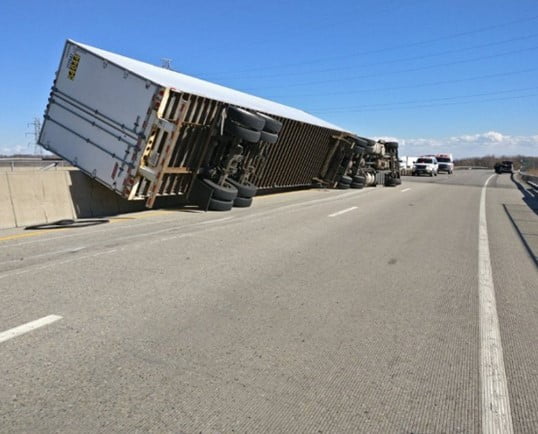
Wind gusts reaching 80 mph flipped multiple 18-wheelers along the New York State Thruway in western New York. Photo courtesy of Monroe County Office of Emergency Management.
“The emergency manager should be involved from moment one on establishing the priority of the critical infrastructure restoration list,” Kohlmeier says. “There are things emergency management may know that the utility does not.”
For example, when Kohlmeier received the critical infrastructure list from the utility during the March windstorm, he recalls that the third building on the list was an unheated shed that stores marine practice equipment for a local fire department that did not need to be prioritized so highly.
Likewise, status update processes should be established pre-incident. “We had 400 sites identified as priority infrastructure,” Kohlmeier explains. “During the event, the utility company knew which of the 400 were out of power, but we didn’t know.”
Coordinating pre-incident can help utilities work more effectively with emergency management to identify the facilities that need immediate attention and monitoring during a power outage.
See more of Kohlmeier’s Tips on communicating with emergency management.
Tim Kohlmeier was appointed deputy public safety director for Monroe County, New York, in February 2017, just two weeks prior to the wind storm that ripped through the county. Prior to his position as emergency manager, Kohlmeier led a 25-year career in fire service, including as assistant fire chief and team leader for special operations. He has assisted with response efforts for Hurricanes Katrina, Sandy and Irene, in addition to many widespread snow and ice storms across the western New York region.

